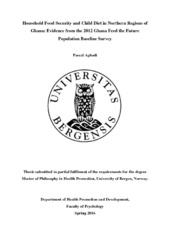| dc.description.abstract | Background and Objectives: There is dearth of literature on the link between household food security and child feeding practices in sub-Saharan Africa. Therefore, this study investigated the relationship between level of household food security and achievement of recommended child feeding practices (minimum meal frequency, minimum dietary diversity, and minimum acceptable diet) in northern regions of Ghana. Also, the study investigated the relationship between socio-demographic characteristics and achievement of recommended complementary feeding practices. Conceptual Framework: The Model of Childcare was used as both the conceptual and analytical framework of the study. The model posits that childcare resources (food security resources, maternal resources, and infrastructure resources) exert influence on child health and development through childcare. Also, happenstances and genes in the childcare model directly influences child health and development. Context in the Model of Childcare either directly exert influence on child health and childcare or indirectly through childcare resources. Methods: Using child data from the 2012 Feed the Future baseline survey (n = 871), logistic regression was performed to assess the impact of household food security factors, maternal characteristics and contextual factors on the likelihood of 6-23 month old infants and children receiving recommended minimum meal frequency, minimum dietary diversity, and minimum acceptable diet. Results: About 36% of children were in food insecure households, and 64% of the children were in food secure households. Chi-Square test of independence indicated inadequate and adequate recommended feeding of children in both food secure and food insecure households. Children in food secure households were significantly more likely than children in food insecure households to achieve recommendations for minimum dietary diversity [O.R= 0.62; 95% CI: 0.43, 0.91] and minimum acceptable diet [O.R= 0.62; 95% CI: 0.40, 0.97]. There was no significant association between household food security status and minimum meal frequency. Compared to infants (6-11 months), children in the age groups 12-17 months [O.R=0.32; 95% CI: 0.21, 0.48] and 18-23 months [O.R= 0.18; 95% CI: 0.12, 0.29] were significantly more likely to achieve to achieve minimum dietary diversity. Also, compared to infants (6-11 months), children in the age groups 12-17 months [O.R=0.34; 95% CI: 0.21, 0.55] and 18-23 months [O.R= 0.42; 95% CI: 0.24, 0.71] were significantly more likely to achieve minimum acceptable diet. Region of residence, household size, and maternal dietary diversity were significant predictors of complementary feeding practices in the northern regions of Ghana. Discussion and Conclusions: There was a decent amount of variance accounted for in the analysis of minimum dietary diversity (.20-.30), modest for minimum acceptable diet (.09-.15) and almost nothing for minimum meal frequency (.02-.03). For minimum dietary diversity and minimum acceptable diet, the models are about the same, and household food security status has importance even accounting for every predictor variable in the models, including a powerful effect of child age. The rejoinder is that how one operationalizes child nutrition care is important; certain aspects of child feeding are significantly related to household food security status (minimum dietary diversity and minimum acceptable diet) and others are not (minimum meal frequency). While household food security was related to two measures of child feeding adequacy, there were instances of underfed children in food secure households and of well-fed children in food insecure households in northern Ghana. Also, child age is related to two measures of child feeding adequacy (minimum dietary diversity and minimum acceptable diet). Although children within the youngest age group (6-11 months) were at risk of being underfed, there were instances of inadequate and adequate recommended feeding of children across the three age groups (6-11 months, 12-17 months, and 18-23 months). The further study of these groups may shed light on how caregivers can be assisted to achieve adequate child feeding, irrespective of the household’s food security situation and the age of the child. | en_US |
